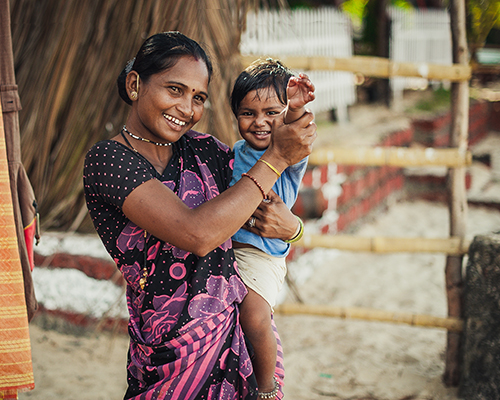Randomised Controlled Trial (RCT)

Randomised controlled trial (RCT) is a popular evaluation design. It is also one of the most straightforward but robust evaluation designs and is considered the gold standard for impact evaluation studies.
Based on the nature of the experiment, the design could be used effectively to test the effect of interventions on outcomes. This process eliminates or minimizes all other potential confounding factors. Consequently, any significant differences observed between the project and control groups can only be attributed to the intervention.
RCT: The process
For the successful implementation of an RCT, it is essential to develop a standardized intervention package to delineate each specific intervention’s attribution.
- An RCT study begins with defining a theory of change that explains how the intervention will affect outcomes and the specific question the evaluation aims to answer. A theory of change describes the process by which an intervention is expected to achieve desired results. This paper explains how and why an intervention will succeed as planned. The document describes the conditions and assumptions that will permit the change to occur.
- Another critical step to a successful RCT is to propose a straightforward evaluation question to assess the program’s impact on an outcome of interest. Data-driven questions must be based on theory and structured as testable hypotheses. It is also essential to include specific outcome measures and evaluation questions to determine whether the program was successful.
- Next, a design for the evaluation needs to be chosen. A full specification of an experimental design can be summarised in three key elements.
- To determine how each intervention will work, you need to define each treatment arm in detail.
- The second element is the level at which the treatment will be randomized, which may not necessarily be the level of the individual.
- The third element refers to the sample proportion assigned to control and treatment groups.
The next step is randomly assigning units to treatment and control groups after the assignment. The program is rolled out after the intervention has taken place
| Concealment and Blinding Concealment is a procedure to protect the randomization process before the subject enters the intervention. Blinding: Blinding the treatment results after randomization has begun. Further Blinding is not always possible. Patients can be biased in their responses if they know about the treatment. It can also result in biased outcome assessment as investigators are aware of treatment. |
Level of Randomisation
One critical aspect of RCT is ensuring a level of randomization. For example, it is essential to decide whether randomization is to be done at a higher level than the individual participant level (sub-centre/village level in case of a health intervention, or school level in case of an education intervention).
We call it a cluster randomization cluster trail (CRT) if we plan randomization at the school or sub-center levels.
Cluster Randomised Control Trial
Many reasons exist why CRT designs might be more suitable than traditional RCTs. For instance, a CRT might be more appropriate if the intervention is for a group or system instead of an individual.
A traditional RCT might be better at finding out if a new intervention doesn’t work for a particular disease or condition.
By contrast, a CRT can determine if a new standard of care, guideline recommendation, or other practice or system-wide change affects outcomes. In addition, a CRT might be more appropriate if the study has a high level of contamination risk. It happens when people adopt parts of an intervention in the group that didn’t get that intervention.
Conducting the Randomization: Ways to randomize
Once we decide on the level of randomization, we can choose from several approaches for guiding the randomization. The most commonly used techniques are:
- Simple randomization: Simple randomization is based on a single set of random assignments, and flipping a coin is the most common way to do it.
- Blocking: This method makes it more likely that each arm will have the same number of people by putting participant assignments in order by block.
- Stratified randomization: Individuals are identified based on significant covariates, and randomization occurs within the strata.
- Dynamic or adaptive methods: This method adapts the allocation probability to match the accrued outcome distribution, thereby favoring the better-performing treatment. A more ethical approach to randomization is often described as using this method.
Sample size finalization
It is essential to highlight that the sample size for RCT is sufficiently large to statistically detect impacts of the desired size for the outcomes of interest. In this context, it is necessary to investigate the Minimum Detectable Impact (MDI), which depends on the result of interest and the Intracluster Correlation Coefficient (ICC) regression R2, which measures the extent to which regression adjustment reduces the variation in the outcome.
Data Collection
The next stage is time for follow-up data collection. It must happen after enough time has passed to observe the effects of the intervention. As a final step, data are analyzed, ensuring that the treatment and control groups are balanced and the results are reported and disseminated. The timelines for experimental studies can, however, vary greatly.
For example, some studies collect baseline data before designing an intervention because the data was collected for another reason. In other cases, no baseline data are collected, and only the difference between treatment and control groups is reported.
A successful impact evaluation requires multiple follow-ups of some interventions to assess how their effects change over time.
| Treatment effects and Analytical Protocol Different treatment effects can be averaged over different parts of the impact distribution. The ATE averages across the entire distribution, wherein ATT averages the distribution impacts for all those assigned to the treatment. In contrast, LATE averages the distribution impacts for people who have switched to the treatment due to a change in some instruments. The most often analyzed populations in randomized controlled trials (RCTs) are the intention-to-treat (ITT) and per-protocol (PP) populations. The ITT population consists of all participants evaluated in their respective randomized treatment arms, regardless of whether they received the treatment or finished the trial. In contrast, the PP population comprises only patients who completed the research per protocol. |
RCT Analysis and Reporting
In theory, randomization ensures that the treatment and control groups are comparable, except for the intervention, so that average outcomes can be compared between the project and control groups.
However, it is more effective to analyze each intervention’s effect using covariance or regression-adjusted data. One can use numerous statistical techniques to analyze continuous outcomes.
An analysis of covariance with a baseline score or with an analysis of covariance with the baseline score and the treatment can be used to examine the post-treatment score. One can also use repeated/constrained measures models to model both the scores before and after treatment.
Binary outcomes can be analyzed using a variety of statistical techniques. It includes logistic regression, Poisson regression, and more recent Poisson regression, which allows for the exact estimation of the standard error.
Reporting
The lack of appropriate reporting prompted the creation of the first CONSORT (Consolidated Standards of Reporting Trials) statement in 1996.
A group of researchers developed CONSORT as a procedure to explore the challenges that can arise during the conduct of RCTs as well as to provide clear and concise conclusions to facilitate the study and evaluation of RCTs.
The CONSORT guideline is continuously modified and revised to provide guidelines for reporting RCTs and CRCTs.
References
- Sibbald B, Roland M. Understanding controlled trials: Why are randomized controlled trials important? BMJ1998;316:201.
- Hulley SB, Cunnings SR. Designing clinical research—an epidemiological approach. Chicago: Williams and Wilkins, 1988.
- Bowling A. Researching methods in health: investigating health and health services. Buckingham: Open University Press, 1997.
- Begg C, Cho M, Eastwood S, et al. Improving the quality of reporting of randomized controlled trials: the CONSORT statement. JAMA1996;276:637–9.
- Altman DG. Randomization. BMJ1991;302:1481–2.
- Schultz KF, Chalmers I, Hayes RJ, et al. Empirical evidence of bias: dimensions of methodological quality associated with estimates of treatment effects in controlled trials. JAMA1995;273:408–12.
- The Standards of Reporting Trials Group. A proposal for structured reporting of randomized controlled trials. JAMA1994;272:1926–31.
- Altman DG. Better reporting of randomized controlled trials: the CONSORT statement. BMJ1996;313:570–1.
Kultar Singh – Chief Executive Officer, Sambodhi
Leave a Reply
You must be logged in to post a comment.

